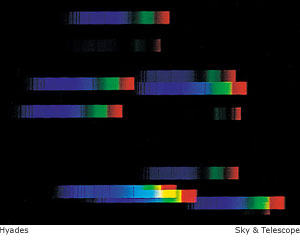Background? We do not assume that you have strong (indeed, any!) previous background
in astronomy, although many of the students will have previously
taken other upper-division astronomy courses or at least had an
introductory astronomy course such as AST~307 or 301.
If you find that there are gaps in your basic astronomy knowledge, please
ask me or the TA to explain or elaborate (either in class or during
office hours).
You might also find it helpful to consult one of the many fine introductory
textbooks that are widely available (I can lend you one of them).
It should take you only a few evenings to master all of the
relevant material that is contained in these books.
Overlap with other courses? There is a small amount of overlap between AST~352K and
AST~358 (Galaxies and the Universe), AST~353 (Astrophysics), and
AST~352L (Positional, Kinematical, and Dynamical Astronomy).
We will try to avoid excessive redundancy, but that is inevitable in
some subject areas, since not all members of the present class will have
taken these other courses.
 Textbook? Nope. This is because I find no single text satisfactory enough to
justify asking you to spend $50-100.
Instead, I will put various texts on reserve in the Peridier
library, and I will recommend readings from them.
I will also post copies of my notes notes on your class web site.
I have alternated teaching this course with Prof. Harriet Dinerstein,
and between us we have pretty much settled on the topics and presentation
order that we like.
All credit for the most recent major upgrade in the class notes goes
to Harriet!
My version will not depart a lot from hers.
Textbook? Nope. This is because I find no single text satisfactory enough to
justify asking you to spend $50-100.
Instead, I will put various texts on reserve in the Peridier
library, and I will recommend readings from them.
I will also post copies of my notes notes on your class web site.
I have alternated teaching this course with Prof. Harriet Dinerstein,
and between us we have pretty much settled on the topics and presentation
order that we like.
All credit for the most recent major upgrade in the class notes goes
to Harriet!
My version will not depart a lot from hers.
Your presentation? Students generally benefit from the experience of researching a
specific topic in some depth.
Toward the latter part of this course you will be asked to give a short
(10 minute) presentation on a topic that deals with some
interesting aspect of stellar astronomy.
Your presentation will be an oral explanation of a poster on the
subject that you have prepared for the occasion.
Your grade will be determined from a combination of astronomical content,
presentation style and effort, and the quality of the poster
that accompanies your presentation.
You will individually prepare and give this small talk on some
narrow stellar astronomy topic, but in the context of a broader topic to be
addressed by a group of students.
There will be three or four broad areas drawn from the latter topics
in the preliminary course outline given below, each of which will
be assigned to a group of three to five students.
The members of the group will work together to decide how to divide up
the larger topic into individual presentations, and will also serve as
a pool of informed people in the same general area, and can (ought to!)
provide an audience for "practice" presentations that (ought to!) take
place prior to the formal presentation in class.
Groups that work together well and give uniformly high-quality
presentations will get "bonus" points added to their grade, giving students
an incentive to help each other.
Your work will be posted to the class web site.

